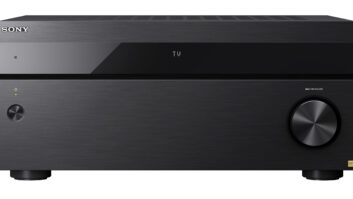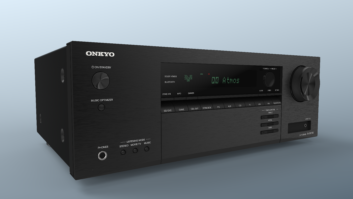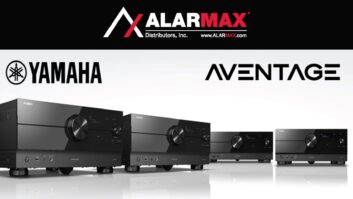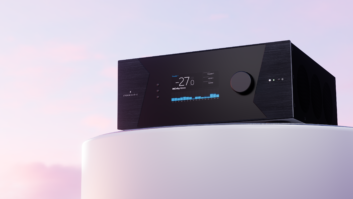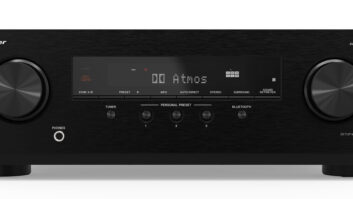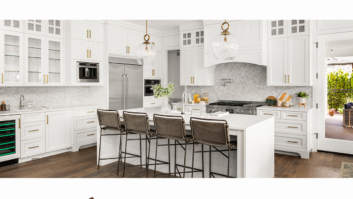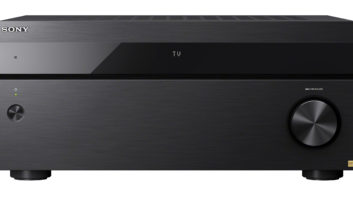I tend to ask integrators a lot of why questions: “Why use that control system? Why this esoteric brand of speaker cable, specifically? Why was that AV receiver or surround processor right for this installation?” The answers to the last question are rarely interesting from a techy point of view, often revolving instead around business relationships and warranties and the like. Excluding the very high end, it’s generally safe to assume that if I do get an interesting, techy answer to that question, the AV receiver in question is probably a Yamaha.

After spending a month or so with the company’s new RX-A1000—the middle offering in its new AVENTAGE line of super sexy upscale AVRs— I’m finally starting to understand why. Cosmetic upgrades and under-the-hood enhancements aside (we’ll get to those soon enough, don’t worry), long-time Yamaha devotees will recognize a lot of familiar functionality here. No Yamaha receiver, for example, would be complete without Cinema DSP 3D processing and the left and right presence channels, designed to be positioned half a meter to a meter outside the main front left and right speakers and 1.8 meters above the floor, that go along with it.
Not only do these additional front channels add a processed vertical element to the surround mix (much like the height channels in Dolby ProLogic IIz and Audyssey DSX, although to these ears Yamaha’s height effect is subtler and a bit more consistent—not as noticeable as ProLogic IIz at its best, but never distracting), but they also enable one of Yamaha’s more compelling features: Dialogue Lift.
In an ideal world, center speakers would be placed directly behind the screen, of course, at the same height as the main left and right channels, but sometimes microperf screens aren’t a viable solution, or—as is the case with my secondary listening room—the display is a flat panel, and the center channel has nowhere to go but beneath. Dialogue Lift allows you to pull the sound from the center channel up a bit by mixing it into those upper speakers, and although it sounds a bit wonky at its extreme setting, dialing it up to around 2 out of 5 went a long way toward alleviating that slight disconnect between faces and voices in my system without negatively impacting dialogue clarity in the slightest.
Another cool, and more recent, Yamaha feature that carries over into the AVENTAGE line is the Scene button, which makes using the same input and device for multiple functions ridiculously easy. Granted, it’s the sort of thing you can do with activity-based macros in most remote control systems, but Scenes make the process so much quicker and easier to program, not to mention execute. So if you use your universal disc player for Blu-rays as well as music, for example, you can quickly (like, literally in a matter of seconds) set up one scene for movies that engages one of Yamaha’s cinema-based DSPs, and another that avoids them altogether, given that DVD-A and SACD are just about the only things I came across in my time with the RX-A1000 that didn’t benefit from the receiver’s signal processing.
My only slight beef is that you can’t make Pure Direct mode part of a Scene, which is a shame, since this is by far the sonically superior solution for multichannel music. It’s a small caveat, though, and easily addressable with one additional line of code in your control program of choice.

Speaking of control, one of the AVENTAGE line’s most notable innovations over the rest of Yamaha’s line is the emphasis on advanced remote control. The line’s Web Control feature adds an easy touchscreen-esque experience out of the box via any PC on the home network, and Yamaha also has developed a handy and fully-featured multizone iPhone control app specifically designed for AVENTAGE receivers.
Where AVENTAGE truly sets itself apart from the pack, though, is in the finer details: separate power supplies for the digital and analog circuit, for example, a fifth foot beneath the receiver for additional stability and vibration damping, meticulous inner construction, and a gleaming, sexy industrial design that simply isn’t done justice by photographs. Even the binding posts are gorgeous, and it’s been a long, long time since I was impressed by binding posts.
From a purely aesthetic perspective, everything about the RX-A1000 screams “high class,” and truly speaks to the additional attention the company has given to the performance of the AVENTAGE line. Granted, I don’t have another Yamaha receiver on hand to compare with the RX-A1000, but I have more receivers in its class than I’d care to admit lying about, and I daresay none of them sounds this sweet, nor are they this feature packed, customizable, and easy to set up.
So next time we chat, don’t be surprised if instead of asking why you installed the receiver you did, I ask, “Why didn’t install an AVENTAGE instead?”
714.522.9105
www.yamaha.com/yec
Kudos
The RX-A1000 boasts superb build quality, dropdead gorgeous looks, and oodles of features perfectly suited to custom integration.
Concerns
If you’ve never installed a Yamaha receiver, all of the company-specific terminology does introduce a weensy bit of a learning curve. Unless, you know, you actually read the manual. Who does that, though?
Product Specs
- 7.2 Channels
- RMS Output Power (20Hz – 20kHz), 105W x 7
- Total Power (20Hz – 20kHz), 735W
- HDMI (In/Out): (8 / 2 ) Ver 1.4a [Zone B Capable]
- i.Link (IEEE 1394)
- Component Video (In/ Out): (4 / 1)
- A /V Inputs (S-Video): 5 (All S-Video)
